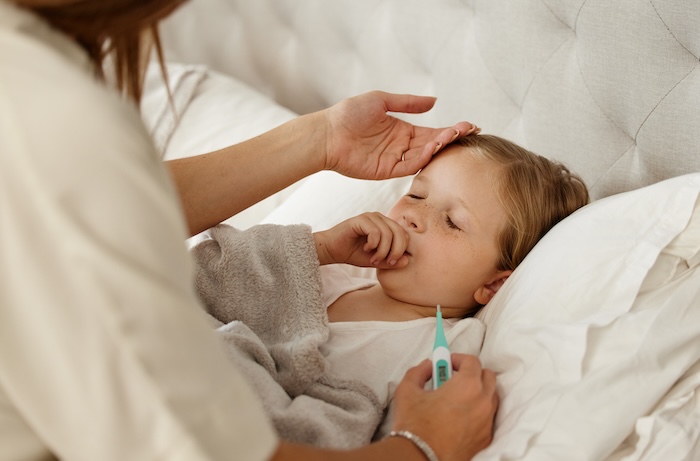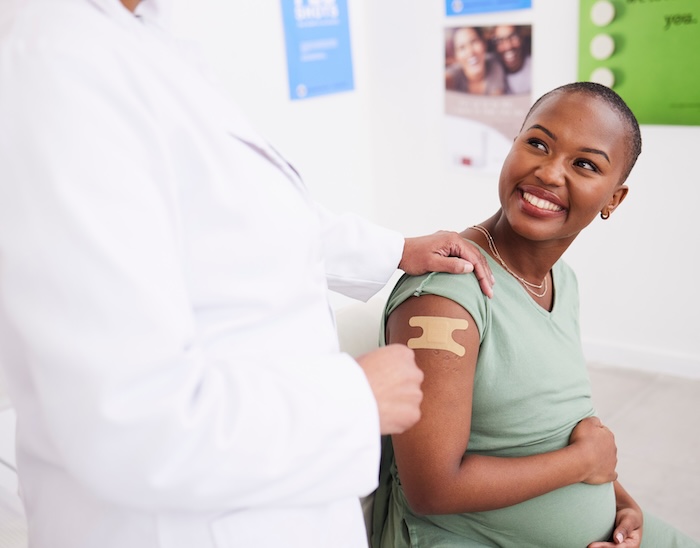At Ocean Pediatrics, we carefully monitor the trends of key illnesses in Orange County to keep our families informed and prepared. Lately, we have noticed an alarming rise in cases of pertussis, or whooping cough, in our community — and at our practice. You might already know that this illness can be dangerous, especially for babies. So, to help you protect your little ones, we’ve written this blog post with all of the must-know info for parents and tips to help you keep your family safe and healthy. Let’s dive in!

What is whooping cough?
Pertussis, also known as whooping cough, is a highly contagious respiratory disease caused by Bordetella pertussis bacteria that can be severe, especially for infants and young kids. It’s well known for the strong, uncontrollable cough and a high-pitched whooping sound when kids take deep, fast breaths between coughs.
How does whooping cough spread?
Much like other common illnesses, whooping cough spreads easily when an infected person coughs and sneezes, releasing the bacteria in the air near another person. However, pertussis can spread even before someone even knows they’re sick — making it easier to spread to others without knowing.

What are the symptoms of whooping cough?
After exposure to the Bordetella pertussis bacteria, symptoms often develop within five to 10 days but can take as long as three weeks to appear. In the first week or two, symptoms often resemble a common cold (runny nose, mild cough, low-grade fever, and pauses in breathing in infants. More severe symptoms of whooping cough can occur as the illness progresses. These include rapid coughing fits with a high-pitched “whoop” and vomiting and/or exhaustion due to coughing fits.
In infants, the cough can be minimal or absent with pauses in breathing which can cause their face to turn red or purple. If you notice any of these symptoms, do not hesitate to call or visit our office immediately or seek emergency care for your infant. Keep in mind, symptoms of whooping cough in adults and older kids might be milder and could be mistaken for another illness.

Whooping cough cases in Orange County
In our office we have seen a clear uptick in cases that are consistent with trends in California. According to the California Department of Public Health (CDPH), over 2,000 cases of pertussis were reported between January and October 2024 — an alarming increase in cases from the last year (fewer than 400 reported cases during the same time).
According to the American Academy of Pediatrics, the number of pertussis cases in the U.S. in 2024 was at least five times higher than in 2023. In Orange County, we have also seen an increase in hospitalizations, particularly among infants and several outbreaks in schools and daycare centers.

How to prevent whooping cough
Keep in mind that cases can occur any time of year but are most common in late summer and fall — so, it’s important to be careful year round. In addition to practicing good hygiene and avoiding others when showing symptoms, vaccination is the most effective way to protect your family and community. People who do contract this illness typically experience milder symptoms and are less likely to spread the disease if they are vaccinated. When a high percentage of the community is vaccinated against pertussis, it becomes much harder for the disease to spread.
Herd immunity
Vaccination not only protects your family but also contributes to “herd immunity” — a form of indirect protection when a large proportion of the population becomes immune to an infection. This can be crucial for protecting those who can’t be vaccinated, such as newborns and individuals with certain medical conditions.

Whooping cough vaccine recommendations
We highly encourage all of our families to stay up to date on vaccines for whooping cough — DTaP for children and Tdap for adolescents and adults. Here’s a quick overview of our recommended schedule:
- Infants and Children: Five doses of DTaP, given at 6 weeks, 4 months, 6 months, 15 months, and 4-6 years
- Adolescents: One dose of Tdap at 10-11 years old
- Adults: One dose of Tdap, then a Td or Tdap booster every 10 years
- Pregnant Women: One dose of Tdap during each pregnancy, preferably between 27 and 36 weeks.
Receiving the whooping cough vaccination while pregnant is safe and highly encouraged! It provides antibodies to the baby, protecting them during the most vulnerable time of life, before they can be vaccinated.

Whooping cough treatment
If you think you or your child has been exposed to pertussis, be sure to contact our office right away as early treatment can be crucial. Please call us if you or your child develops cold-like symptoms that worsen or last longer than two weeks, if anyone in your family notices any signs of whooping cough, or if anyone in your family has difficulty breathing, vomiting, or starts turning blue or red in the face.
Know that pertussis can be very dangerous and even life-threatening for infants. Seek emergency medical care if your baby:
- Struggles to breathe
- Has pauses in breathing (apnea)
- Turns blue or purple
- Has seizures

At Ocean Pediatrics, we’re here to support you, your family, and our community in staying safe from pertussis. Don’t hesitate to reach out to discuss your family’s vaccination records, schedule appointments for a whooping cough vaccination or booster, get trusted information about illnesses in Orange County, or talk about any other health concerns you might have. To make an appointment, visit us here. Until then, we wish you a happy, healthy rest of the winter season!






